 |
 |







|
 |
 |
 |
 |
 |
 |
 moving minnesota through employee communication moving minnesota through employee communication |
 |
 |
 August
15, 2001 August
15, 2001 |
No. 26 |
 |
|
|
 |
 |
 |
FHWA says “no” to opening HOV lanes
|
 |
 |
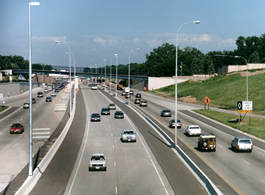 |
The Federal Highway
Administration has barred Mn/DOT from opening the high occupancy vehicle
lanes on I-35W and I-394 (above) to general traffic. Photo by Neil
Kveberg
|
The Federal Highway Administration has barred Mn/DOT from opening the high
occupancy vehicle lanes on I-35W and I-394 to general traffic.
At issue is a $100,000 study ordered by the Minnesota Legislature to see how
opening the bus and car pool lanes would affect traffic flow and safety on the
interstates. The legislation includes language that prohibits Mn/DOT from conducting
such a study if it affects federal funding.
Special funding was used to build the HOV lane on I-35W with federal law prohibiting
Mn/DOT from opening it. Federal officials believe opening the I-394 lanes at
this time would erode popular transit incentives and could have a serious detrimental
affect on the future use and acceptance of HOV facilities.
If Mn/DOT does not comply with FHWA guidance on the I-35 and I-394 HOV lanes,
officials say all new federal funding for projects in the Twin Cities Metro
area will be withheld for as long as occupancy requirements are suspended.
Federal officials are, however, encouraging the state to conduct an alternative
study that would not involve physically changing current HOV lane operations.
Follow these links to view Mn/DOT’s Aug. 9 news release
and recent
articles in the Twin Cities daily newspapers.
For more information about the HOV study, contact Paul Czech, Metro Division,
651/582-1771.
By Jeanne Aamodt
|
back

|
 |
Aeronautics’ role in promoting aviation gains speed, altitude during past 25 years
|
 |
 |
Editor’s note: This is one in a series of articles Newsline
will publish looking back on Mn/DOT’s first 25 years—remembering the people,
issues and cultural forces that have shaped the agency and the milestones Mn/DOT
has achieved. If you have a memory about Mn/DOT you’d like to share, please
send it to Mn/DOT
Newsline.
 |
|
Three Central Office
employees arrive for a meeting in Willmar after deplaning from one of
Aeronautics’ passenger aircraft. Photo by Cheryl Plathe
|
During the winter of 1913, a fragile, spidery, push-propeller biplane lifted
its pilot over downtown Minneapolis. The biplane, akin to an ultralight aircraft
today, arced across the cityscape, marking the first such event in the city’s
history.
Thirty years later, the Minnesota Legislature, noting the effect aviation was
making on the state, created the Department of Aeronautics and the Metropolitan
Airports Commission.
In 1976, the Department of Aeronautics was incorporated into the new Department
of Transportation. Its commissioner, Larry McCabe, became an assistant commissioner
with the newly formed Mn/DOT. Dick Keinz succeeded McCabe in 1981. Subsequently,
Ray Rought, the current director, was appointed to lead Aeronautics in 1986.
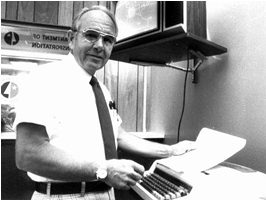 |
|
Jim Baker, a former
chief pilot with Aeronautics, gets a weather report generated by the Air
Weather Observation System.
|
Although it became a part of Mn/DOT in 1976, the former department retained
its primary mission: promoting aviation safety and aviation’s role in strengthening
the state’s economy.
In 1992, Aeronautics staff consolidated their operations at its current location
on Plato Boulevard in St. Paul. Previously, staff members were housed in the
Transportation Building, the terminal at the St. Paul Downtown Airport and a
shop on Chester Street.
The move helped Aeronautics focus its resources and energy on refining current
programs and developing new ones such as its weather information program for
pilots.
The program started in 1983 as a TV broadcast service on Channel 17 in the
Twin Cities. It was later expanded to include computer terminals at airports
where pilots could get printouts of current conditions and forecasts. It also
enables pilots to electronically file flight plans with the Federal Aviation
Agency.
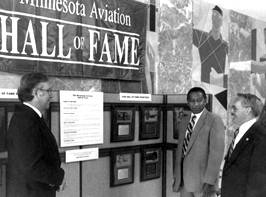 |
|
Viewing a display recognizing
Minnesota’s aviation pioneers are (from left) Ray Rought, director, Aeronautics,
Ken Wofford, a retired Aeronautics manager, and Duane Haukebo, assistant
director, Aeronautics. Photo by Kent Barnard
|
The system also provides pilots with directional headings and reports on the
length of time and the amount of fuel it will take a specific kind of aircraft
to reach its destination.
Sixty-one AWOS (Aviation Weather Observation System) sites feed weather data
to the terminal system and the national weather database. More than 17,500 pilots
licensed in Minnesota now can use the service from home via the Internet.
In conjunction with the FAA, Aeronautics also operates a network of navigational
beacons for fliers. The beacons generate radio signals that enable pilots to
determine their current position and make needed course corrections.
But the service most visible to Mn/DOT employees might be Aeronautics’ air
passenger service for state employees and elected officials. The service enables
passengers to reach distant locations, conduct their business and return the
same day. Mn/DOT’s fleet now includes two turbo-prop Beechcraft King Air aircraft
and a jet-powered Cessna Citation.
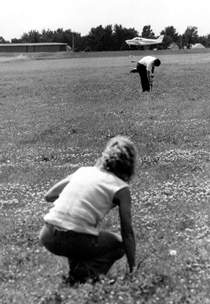 |
|
Staff from Aeronautics
conduct an inspection at a Minnesota airport to ensure it meets operational
standards.
|
Closer to the ground, Aeronautics’ airport pavement management program provides
the information to help airport managers plan maintenance or reconstruction
for paved runways and taxiways.
Staff members are currently installing or improving instrument landing system
facilities at eight state airports.
Aeronautics staff also conduct an airport inspection program to ensure the
state’s 140 publicly owned airports meet safety and operational standards.
Since its creation, Aeronautics has conducted extensive marketing and educational
efforts. They include a partnership with the FAA to establish an air traffic
control training center at the Flying Cloud Airport in Eden Prairie and a partnership
with Minneapolis’ Washburn High School to create a curriculum for aviation education.
That curriculum now serves as a model for other states.
The components of Aeronautics’ mission add up to support a major Minnesota
industry, from a small airstrip in Northwestern Minnesota to the international
Minneapolis-St. Paul Airport in the Twin Cities that generates more than $10
billion in economic activity statewide.
“As air traffic continues to grow in the Twin Cities area,“ said Duane Haukebo,
Aeronautics assistant director, “we may need to focus on ‘reliever’ airports
in nearby cities and creation of new intermodal facilities statewide where air,
rail, and surface transportation modes would connect to provide increased mobility
for the state’s growing and diversifying economy.”
For more information about the office and its programs, see the Aeronautics
Web site.
By Craig Wilkins
Front page photo: Dotted throughout the state, these VOR (Very High Frequency
Omnirange) radio beacons provide a reliable electronic navigational system for
aviators.
|
Mn/DOT memory. . .
“A landmark change that occurred during the past 25 years is creation
of the Minnesota Council of Airports. This grassroots organization creates
a listening post for Aeronautics and has helped us shape policy toward
funding airport improvement programs and building our reputation for
constituent service.”
—Dave Nybakken, retired director, Airport
Development Section, Aeronautics
|
|
back

|
 |
Planes, trains, ships and trucks: even “mechanical worms” travel multi-modally
|
 |
 |
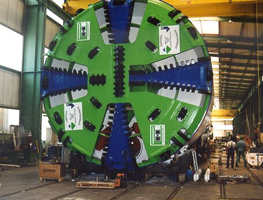 |
Before traveling multi-modally
to its new job in Minnesota, this tunnel-boring machine visited this warehouse
in Rotterdam, the Netherlands, where workers retrofitted it to handle
the rock forms beneath the Minneapolis-St. Paul International Airport.
Photo by Jack Brockway
|
It’s called a “mechanical worm,” but this 500-ton globetrotting machine will
use any mode of transportation that can carry its bulk.
Its destination: the Minneapolis-St. Paul International Airport; its mission: drilling for the Hiawatha light rail transit line.
By the time the “worm”—otherwise known as a tunnel-boring machine—arrives
at the airport on Aug. 20 from the Netherlands, it will have traveled by ship
across the Atlantic Ocean and cruised the St. Lawrence Seaway and the Great
Lakes, with a scheduled arrival date of Aug. 17 at the Duluth/Superior seaport.
In Duluth, warehouse workers will load the machine in sections onto flatbed
trucks heading south for Minneapolis/St. Paul during the early morning and nighttime
hours of Aug. 20 (4:00 a.m. for the first set of trucks; late that night for
the second set of trucks). The trucks will bear signs saying: ”LRT is on track.”
The trucks will need special overload trucking permits for this overnight journey.
That’s partly because its two largest sections will ride on side-by-side trucks
with parallel trailers, thus taking up two lanes of traffic at the same time.
The convoy will also include a State Patrol car and escorts from Kirscher Trucking
of Virginia, who will help synchronize the side-by-side trucks during the journey.
Once the machine arrives at a Fort Snelling field near the airport, crews will
reassemble it—a task that’s expected to take several weeks. Sometime around
Halloween, the machine can begin its 16-month job of eating underground rocks
to tunnel and simultaneously pave a section of the future LRT line
being built by Mn/DOT.
The machine’s work will ultimately assist globetrotting humans to travel multi-modally
as well, besides helping to reduce traffic congestion
on metro area highways. The tunnel that the machine will dig will link
the airport’s passenger terminal to the LRT line connecting the Nicollet Mall
and the Mall of America.
|
back

|
 |
Business booms at Twin Cities park and ride lots
|
 |
 |
Twin Cities
commuters increasingly are choosing “park and ride” as their preferred way to
get to work. Many of the 155 park and ride lots in the Twin Cities Metro area
are full and growing demand for the service is prompting an expansion at more
than half a dozen park and ride lots, according to Aaron Isaacs, facilities
planning manager, Metro Transit.
Part of national trend
The local numbers tell the story of what is a national trend:
§
The busiest park and ride in the Twin Cities is the Foley Ramp
in Coon Rapids where 1,000 of its 1,243 parking spaces are used Monday through
Friday.
§
The second busiest is in Burnsville where all 1,000 spaces are
claimed. Minnesota Valley Transit, which runs the lot, plans to add another
350 spaces this fall.
§
In the western Metro area, along I-394, four of the six biggest
park and ride lots are full. Out of more than 1,000 spaces, just 85 remain open
daily.
§
Across the Metro area, the 26 largest lots are about 75 percent
full.
Growing demand
Although park and ride lots have been around since the early 1970’s,
Isaacs said, they’ve really taken off in the past five years. He credits their
rise in popularity to three factors:
§
More jobs in downtown Minneapolis—The Department of Economic Security
reports the downtown area has added more than 10,000 jobs during the past five
years.
§
More traffic congestion—The Texas Transportation Institute reports
during the past 20 years, the percent of congested freeways in the Twin Cities
has more than tripled. The average resident now spends almost half of his/her
daily travel time in congested traffic.
§
HOV lanes and bus-only shoulders—Isaacs
said the HOV lanes on I-35W and I-394, as well as approximately 160 miles of
bus-only shoulders, makes riding the bus one of the fastest commuting games
in town. Commuting times are expected to improve as Mn/DOT adds another 10 to
20 miles of bus-only shoulders each year.
Many of the park and ride lots are the result of a team effort by Mn/DOT,
Metro Transit, the Metropolitan Council, transit companies and local communities.
John Griffith, Metro Division area engineer, calls the park and ride lots an
important piece of the department’s strategic Moving Minnesota plan.
“The expansion of current lots and the creation of new ones are key elements
in Moving Minnesota’s plan to provide more transportation choices and to reduce
congestion,” Griffith said. “Traffic congestion is growing across the country
and interest in mass transit is increasing. The park and ride lots are
one important way Mn/DOT is making it easier and more attractive for more and
more Minnesotans to choose mass transit.”
Future lots
Where will the next park and ride lots be located? According to Issacs, new
lots will be built or current lots expanded in Blaine; Elk River; Big Lake (park/pool
lot) and Riverdale in Coon Rapids, where lots will service the new Northstar
Commuter Coach express bus service; Fort Snelling, which will service the Hiawatha
Light Rail Transit line; Cottage Grove; Maplewood; Roseville, and Woodbury.
Parking is free and available on a first come, first serve basis. For more
information, see the Twin Cities park and ride
Web site or call 651/602-1602. Click here for information on park and ride lots
in greater Minnesota.
By Pat Lund
|
back

|
 |
Employees use Farmfest to plant work zone safety message
|
 |
 |
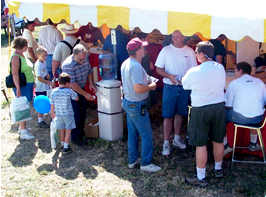 |
The water cooler was
a “hot” commodity at Mn/DOT’s exhibit at Farmfest, an annual agricultural
show held last week in Redwood County. Photo by Brian Bruckhoff
|
Not only is Mn/DOT taking its work zone safety
message to the streets, it’s also taking it to the farms—or farmers, to be exact.
Employees from Districts 6, 7 and 8—all members
of the work zone safety speakers bureau—staffed Mn/DOT’s exhibit at Farmfest
2001, held Aug. 7-9 in Redwood County. Located on a farm southeast of Redwood
Falls, Farmfest is an annual show featuring indoor and outdoor exhibits, field
demonstrations, craft booths and educational seminars of interest to farmers
and their families.
Mn/DOT shared exhibit space with the Department
of Public Safety and was one of 450 organizations participating in the three-day
event, which typically attracts more than 45,000 people.
“Farmfest provides the opportunity for Mn/DOT to
educate people about summer and winter work zones,” said Sandy East, District
8 public affairs coordinator. “It’s also a great public relations tool to be
out-and-about with our customers.”
In greater Minnesota, a large number of those customers
include farmers. Mn/DOT partners with farmers, for example, to create living
snow fences (rows of plants, such as corn stalks, left standing alongside highways
to serve as a natural barrier against drifting snow). The department also hires
farmers as temporary employees in the winter, East said.
Mn/DOT’s exhibit included a snowplow and work zone
safety information, as well as giveaway items such as brochures, pencils, bookmarks
and state highway maps. Staffing the booth were District 6 employees Joe Huneke,
Cameron Ihrke, Gary Zech; District 7 employees Brian Bruckhoff, Deb Yates; and
District 8 employees Darrell Carlson, Bruce Schlueter and Hugh Smith.
With hundreds of organizations competing for the
crowd’s attention in the 90-degree-plus heat, how did Mn/DOT attract an audience
for its message?
“The water cooler stationed at the front of the
exhibit was a ‘hot’ commodity and a good draw,” East said.
Click here for more information about work
zone safety.
|
back

|
|
 |
|
|


